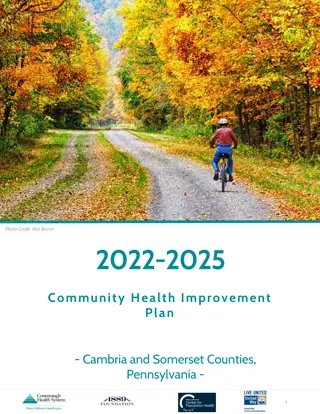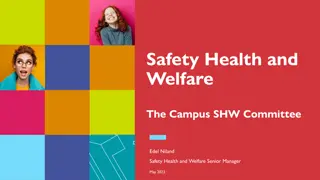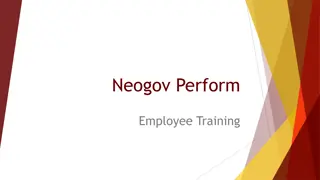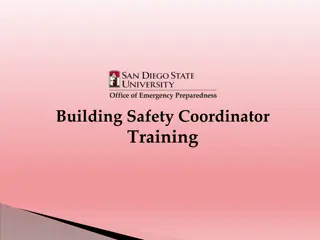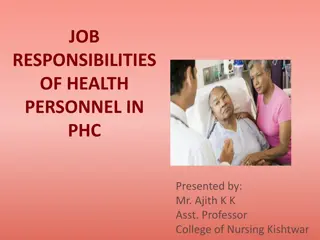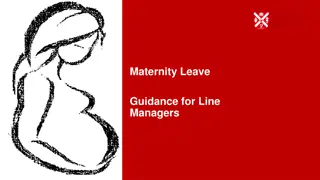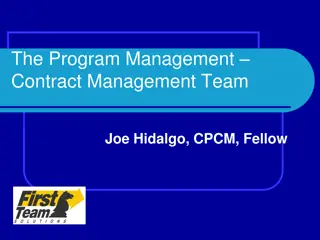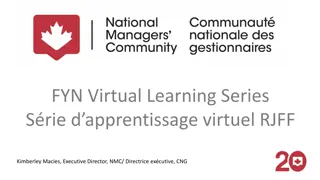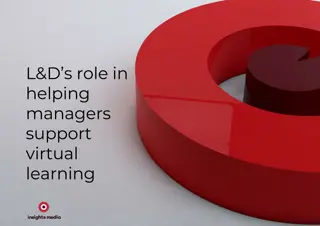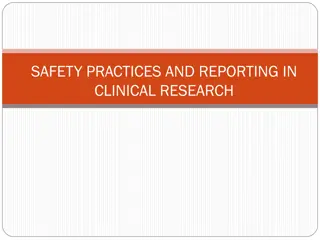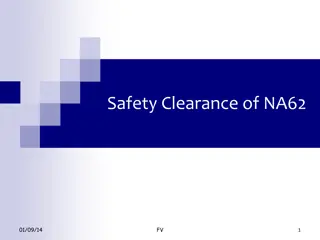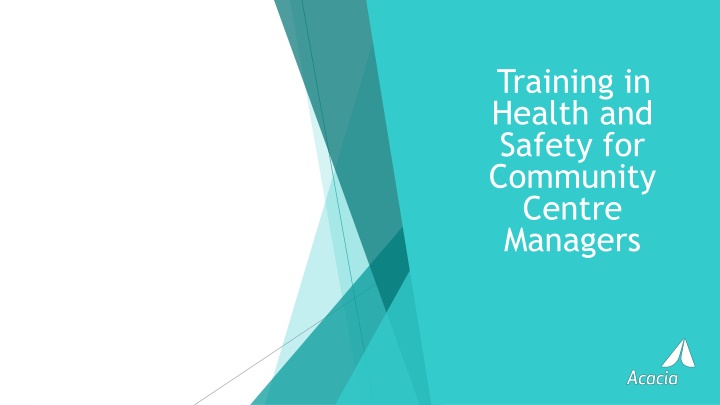
Health and Safety Training for Community Centre Managers
This training program is designed to raise awareness among community centre managers about their responsibilities in managing health and safety in community centres. It covers topics such as safety statements, risk assessment, emergency preparedness, welfare facilities, and first aid. The program aims to equip managers with the knowledge and skills needed to ensure a safe environment for staff and visitors at community centres.
Download Presentation

Please find below an Image/Link to download the presentation.
The content on the website is provided AS IS for your information and personal use only. It may not be sold, licensed, or shared on other websites without obtaining consent from the author. If you encounter any issues during the download, it is possible that the publisher has removed the file from their server.
You are allowed to download the files provided on this website for personal or commercial use, subject to the condition that they are used lawfully. All files are the property of their respective owners.
The content on the website is provided AS IS for your information and personal use only. It may not be sold, licensed, or shared on other websites without obtaining consent from the author.
E N D
Presentation Transcript
Training in Health and Safety for Community Centre Managers
Introduction This Training Programme is designed for Centre Managers, to ensure they are aware of their responsibility with regard to managing health & safety in Community Centres. The purpose of this training is to highlight the hazards associated with Community Centres and how to eliminate or mitigate them.
Safety Statement The Safety Statement is the Community Centre s Safety Management System. The Safety Statement is maintained by the Environmental Health & Safety (EHS) Department and is filed in Reception. The Safety Statement is brought to the attention of all staff on a yearly basis. The Safety Statement should be communicated to all new employees on induction, including scheme workers.
Risk Assessment Risk Assessments are completed for each Community Centre and are issued to all staff working in the Community Centre. The Centre Manager has a duty to ensure that the Employees understand the content of the Risk Assessments and must supervise compliance with the requirements. Risk Assessments are carried out by the EHS Department and are filed in Reception. Risk Assessments are reviewed on a yearly basis or if there is a change in the working environment. It is the Centre Manager s responsibility to close out on the actions recommended in the Risk Assessment.
Emergency Preparedness and Response Emergency Evacuation Plan in place for all Centres. Centre Managers must ensure that there are trained Emergency Controllers and Fire Wardens in place. Fire drills are to be held twice annually. Fire drills are to be recorded in the Fire Register. Daily Fire Checks are to be documented. The Centre Manager is responsible for ensuring that the maintenance of emergency equipment (e.g., emergency lighting, fire extinguishers, fire alarm) is upheld. The emergency exit door must be fitted with suitable panic hardware and under no circumstances should doors be locked while the Centre is occupied. Alarm Activation Refer to the site-specific Emergency Response Plan
Welfare Facilities Canteen. Toilets. Accessible Toilets for people with reduced mobility. Personal Emergency Egress Plan. First-aid Responders. Fire Wardens.
First Aid First-aid Boxes to be mounted on the wall to ensure visibility and accessibility. Body Fluid Kits. Burn Kits. Eye Wash Station. No creams or medications are permitted apart from aspirin (300mg) recommended to be given for suspected heart attacks. Contents of the First-aid Boxes to be inspected and a checklist filed (Health and Safety Authority checklist included in site-specific ERP). First-aid Responders details to be communicated. Automated External Defibrillator (AED) to be inspected to ensure the following: AED has a green light. No visible damage. Pads are in date and sealed. Accessory equipment is present and in date.
Accident / Incident Reporting All accidents / Incidents and Near Misses must be reported to the Centre Manager immediately. Report to local trained FAR (First-aid Responder) An accident report form EHSF-03 must be completed in conjunction with line manager/ supervisor The Centre Attendant should contact the Centre Manager immediately of any incident which requires Emergency Services to be contacted The Centre Manager must notify Acacia s EHS department of any incident without delay and at least within 24 hours of the incident occurring The Centre Manager must send the accident report form to the EHS department Accident/ Incident Investigations will be initiated by Acacia EH&S department as required Once approved by the EHS department, the incident report form should be sent to the Centre Insurance company by the Centre Manager
Housekeeping Floors should be cleaned during non-peak times. Wet floor signs should be used at all times. Minimal water should be used. All cleaning products / chemicals / cleaning trolley should be locked away when not in use. Trailing cables should be covered. Storage of combustibles should be minimised to reduce fire load.
Housekeeping Daily checklist should be in place that includes housekeeping. Passageways should be kept clear at all times. All floors should be inspected at regular intervals to ensure that no trip hazards are present (document check). Work areas should be cordoned off and work equipment stored neatly. A clean as you go approach should be adopted at all times. Items should not be stored at height / in corridors / under stairwells / in front of first-aid facilities / fire-fighting equipmen.t Sports equipment should be stored in designated storage area.
Room Set-ups Room to be clean and tidy before each set up. Work should only by done by staff who have had manual handling training. Lightweight furniture should be selected where furniture is required to be moved regularly. Mats should be placed over trailing cables. Extension cables should be fully unwound.
Sports Equipment Lightweight / easy-to-move sports equipment should be sourced where possible. Sports equipment should be inspected frequently. Sports equipment should be secured before use and dtored in adequate storage area when not in use. Nets should be inspected by a competent person.
Operation of the skyfold Ensure the area is clear before and during operation of the sky-fold A second staff member or group leader may be required to assist if the area is occupied Never operate the sky-fold if there is a person within three meters of the sky- fold Always keep fingers and hands clear of the moving wall to prevent entrapment Always ensure that operators do not have loose clothing
Safe Lifting and Handling Centre Managers must ensure that all personnel who are authorised to carry out manual handling tasks have received manual handling training. Manual handling training must be delivered by a QQI Level 6 Manual Handling Instructor. Training must be specific to the tasks completed by personnel. Refresher training every 3 years. Safety footwear must be worn. The requirement for manual handling should be eliminated where possible. If high-risk manual handling is required, a task specific Risk Assessment should be conducted by a Manual Handling Instructor. A high-risk manual handling task could include heavy weight items, repetitive tasks, awkward postures, or tasks outside individual capabilities.
Safe Use of Work Equipment Employees are required to inspect work equipment prior to use, to ensure that it is fit for purpose (e.g. cleaning equipment taski buffer, vacuum). Employees should only use work equipment that they have been trained to use. The Centre Manager should encourage employees to report any defects with work equipment. The Centre Manager is responsible for arranging the repair or replacement of faulty work equipment. The Centre Manager is responsible for ensuring that Portable Appliance (PAT) Testing is completed on portable appliances. The use of personal electrical appliances is discouraged. The use of portable heaters and fans is discouraged. The use of power tools by Centre staff is strictly prohibited.
Display Screen Equipment (DSE) Assessments DSE Display Screen Equipment. DSE users of 1hr+ per day. DSE Assessment ergonomic assessment of workstation set-up. All Employees who use a DSE (for more than 1 hour per day) have a legal entitlement to an eye test provided by their Employer. For Acacia employees a voucher is issued by the EHS Department, to be provided to Specsavers (store of your choice). Each voucher provides a full eye examination. If Employees require glasses solely and specifically for DSE use, Acacia will cover a pair of glasses from the 59 range or alternatively contribute 59 towards an upgraded range of choice (further 30 contribution when glasses are selected from the 149 range or above)
Security Reception should always be manned where possible. Access control system in place in most centres It is recommended that two members of staff are requested to attend onsite for locking up building. Where one person is locking up, a security company should be assigned and contacted to assist with the locking up of premises. or The last group to leave agrees to stay with staff member until the main gates are locked. CCTV Centre Managers should be familiar with the requirements of the CCTV Policy. Panic alarms location / operating? Public address system everyone should be instructed to evacuate if required. A Cash Handling Procedure should be in place. Electronic or cheque payments are preferred over cash. Two people should visit the bank when the cash is over a certain limit (over 3,501 up to 5,000). Valuables should be kept out of sight.
Violence, Harassment, Aggression (including antisocial behaviour) The door of the office should be closed and locked if anyone feels they are in danger. They should raise the alarm (contact another member of staff for assistance). They should ask the person to leave. If the person is becoming aggressive, they should not react but remain calm. They should not make physical contact. They should call the Garda if the situation escalates. If the situation involves a person participating in a group or an event onsite, they should report the incident to the Group Leader. All incidents of aggression should be reported to the Centre Manager as soon as possible.
Chemical Safety An SDS (Safety Data Sheet) should be kept for all chemical agents stored on site. Only approved chemicals are permitted to be used (approved by the EHS Department). Chemicals should not be left in public areas unattended. Appropriate gloves should be available for handling chemicals. Chemicals should be stored in accordance with the storage information on the SDS. Chemicals should be disposed of as hazardous waste (e.g. paint). Acacia does not permit chemicals to be used for unblocking drains. In the event of an emergency with a chemical, the SDS should always be consulted and medical assistance sought without delay.
Sharps Availability of sharps should be kept to a minimum (e.g. large kitchen knifes should not be kept in Centres where food is not prepared). Enclosed blade or retractable safety knifes should be provided if required. Sharps should be stored so that they are visible and not concealed. In the event of needlesticks being identified on site, these should be removed by a specialist. The provision of sharps containers should be considered, for example where Employees are diabetic. When disposing of broken glass or crockery, ensure that cut-resistant gloves are worn. Glass or crockery must be enclosed to prevent cut hazards (e.g. they should be wrapped or boxed).
Personal Protective Equipment (PPE) Centre Managers are responsible for ensuring that Employees are provided with the appropriate PPE . Centre Managers are responsible for supervision of compliance with the requirement to wear PPE. To ensure that all Employees have access to the correct PPE for the task they are undertaking, a pre-defined, the Centre Manager should provide an approved list of PPE from an approved supplier. The requirement for PPE is identified through the site-specific Risk Assessment Process.
Legionella All Centre Managers should undergo Legionella Management Training available on LMS. If they have not received this training, they should escalate this so that it can be arranged. The Centre Manager is responsible for ensuring that an adequate Legionella Management Programme is in place.
Contractor Management Only contractors who meet the minimum requirements can be permitted to carry out works in Community Centres: Minimum Employers and Public Liability Insurance ( 13m and 6.5m respectively). Suitable competency training, experience, qualifications. Adequate site-specific Risk Assessment & Method Statement (RAMS). Where applicable, there should be evidence of statutory inspections completed on work equipment (e.g., mobile elevating work platforms [MEWP], harness). Permit to Work to be issued. Supervision.
Noise Noise should be kept below levels that may cause damage to individuals hearing. For example, if a person has to shout to be heard from a distance of 2 metres away, then noise levels are deemed high enough to cause damage, for instance from: Loud music. Power tools.
Working at Heights A two-step platform can be used by Centre Employees. Only Acacia Technicians and Contractors are permitted to work at heights / access to roof. Roof access must be approved in advance by the Centre Manager. Where access to the roof is required, safe system of work must be in place. Fragile surfaces must be identified, communicated and considered. Permit to Work. Non-peak times. No work at heights should take place during adverse weather conditions.
Confined Space A confined space definition. Centre Managers are responsible for ensuring that all confined spaces are identified and labelled Where access to confined spaces is required, this should be completed by a competent person. A Confined Space Risk Assessment is required. A Confined Space Permit must be issued. All confined space entry must be notified to the EHS Department in advance (at least 48 hours in advance).
Asbestos Asbestos is present in some Community Centres. The Centre Manager is responsible for ensuring that an Asbestos Management Survey is carried out. The findings of the survey should be communicated to all people carrying out work on site. Asbestos should be considered for all maintenance work that may have the potential to disturb it and controls should be implemented to prevent exposure.
Adverse Weather National weather alerts should be monitored. Where the temperature is expected to drop below 4C, action may be required. If there is a national alert that is sufficiently high and deemed to pose a risk (i.e. a red weather warning), a communication will be issued from Senior Management advising on the appropriate steps to take. De-icing salt should be spread by staff on pedestrian walkways using a manual de-icing device (this requires manual handling training. Where the temperature is expected to drop below 2C, a Site-specific De-icing Plan comes into effect. No work at heights should take place during adverse weather conditions.
Lone Working High-risk lone working should not take place in Community Centres. The Centre Manager / Supervisor must be made aware if lone working occurs. High-risk tasks such as working at heights or electrical maintenance must not be carried out alone. It is recommended that two members of staff are requested to attend onsite for locking up buildings. Where one person is locking up, a security company should be assigned and contacted to assist with this. Please refer to the Lone Working Policy in the Site-specific Safety Statement, which covers many points, including the need to check in with another person / Centre on a regular basic if working alone.
New Employee Induction Emergency Evacuation Procedure - Fire Extinguisher Locations, Fire Routes and Assembly Point, The Sign in / out book and handover procedure. Accident and Incident reporting. Any operational information they may require, for example: Operation of Fire Panel (if relevant). Operation of Intruder Alarm (if relevant). First-aid Responder details. Operation of cleaning equipment and products. Skyfold operation / basketball board operation switch. Daily check sheets, etc.
New Groups Insurance documentation. Contracts. Communication of emergency procedures. Communication of incident reporting procedures. Communication of sign in / out procedures.
Events on site A Health & Safety Plan and Risk Assessment will need to be in place prior to any scheduled events onsite. It is recommended that smaller events are also adequately assessed: A template is currently being developed by Acacia EHS work in progress. The EHS Department will review risk assessment template for events. The Centre Manager must approve all such plans, including insurance. The EHS Department is consulted with regard to health & safety arrangements for site events. All personnel providing services at such events must be approved by Centre Management appropriate insurance, RAMS, etc. A Staff Management Plan for events is established. First aid. Supervision. Events can include fun days, summer camps and Christmas markets.
Employee Wellbeing A healthy work-life balance should be maintained. The workload should be managed. Employee Assistance Programme EAP. Employee Wellbeing Committee. Employee concerns should be listened to. Where necessary, feedback should be provided. HR should be consulted for further details, for example, bullying and harassment.
Smoking Centre Managers must ensure that a Smokefree Workplace Policy is in place that defines where smoking can and cannot take place. They must enforce the requirements of this Policy. No Smoking signage should be displayed.
General Safety Centre Managers must ensure adequate maintenance of door closers to prevent finger entrapment, particularly for minors. They should ensure that blind cords are secured and quick release devices fitted. They should consider window restrictors, where there is a risk to children. Centre Managers should have an understanding of the ownership of external areas.


